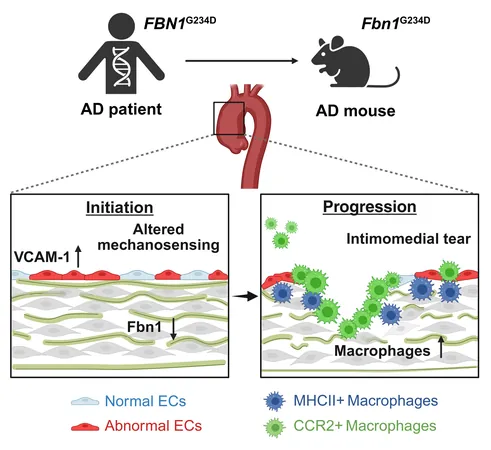
Unraveling Aortic Dissection: The Immune Response Behind a Deadly Condition
2025-05-27
Author: Jia
Aortic dissection is a critical, life-threatening emergency marked by the sudden rupture of the aortic wall, often leading to catastrophic vascular collapse. This condition demands immediate medical intervention.
Those with inherited connective tissue disorders, such as Marfan syndrome, face heightened risks, often developing aortic dissection at a young age. This underscores a desperate need for innovative preventive measures and treatment options. Yet, the exact molecular forces that trigger and escalate this perilous condition remain shrouded in mystery.
A groundbreaking study in *Circulation Research*, led by an international team from the University of Tsukuba, has unveiled important insights. Researchers engineered a mouse model that spontaneously develops aortic dissection by inserting a specific missense variant into the fibrillin-1 (FBN1) gene. This genetic alteration, identified from a familial aortic dissection case, leads to the production of a faulty fibrillin-1 protein.
The affected mice exhibited significant intimal-medial tears in the ascending aorta, with the dissection worsening alongside an alarming influx of inflammatory cells, ultimately resulting in a deadly rupture.
Histological and gene expression analyses revealed that dysfunctions in vascular endothelial cells occur prior to dissection, enabling the infiltration of monocytes and macrophages into the intima. Notably, these macrophages displayed both inflammatory and anti-inflammatory characteristics.
Further examination revealed that the missense variant in the FBN1 gene disrupts the vital binding process between fibrillin-1 and proteins that bind transforming growth factor beta (TGFβ). This alteration diminishes TGFβ signaling, a crucial pathway for maintaining vascular stability.
These pivotal findings indicate that the interplay between dysfunctional vascular endothelial cells and immune macrophages—combined with compromised TGFβ signaling—forms a fundamental molecular framework underlying the pathogenesis of aortic dissection. This research may pave the way for new therapeutic strategies aimed at combatting this life-threatening condition.


 Brasil (PT)
Brasil (PT)
 Canada (EN)
Canada (EN)
 Chile (ES)
Chile (ES)
 Česko (CS)
Česko (CS)
 대한민국 (KO)
대한민국 (KO)
 España (ES)
España (ES)
 France (FR)
France (FR)
 Hong Kong (EN)
Hong Kong (EN)
 Italia (IT)
Italia (IT)
 日本 (JA)
日本 (JA)
 Magyarország (HU)
Magyarország (HU)
 Norge (NO)
Norge (NO)
 Polska (PL)
Polska (PL)
 Schweiz (DE)
Schweiz (DE)
 Singapore (EN)
Singapore (EN)
 Sverige (SV)
Sverige (SV)
 Suomi (FI)
Suomi (FI)
 Türkiye (TR)
Türkiye (TR)
 الإمارات العربية المتحدة (AR)
الإمارات العربية المتحدة (AR)